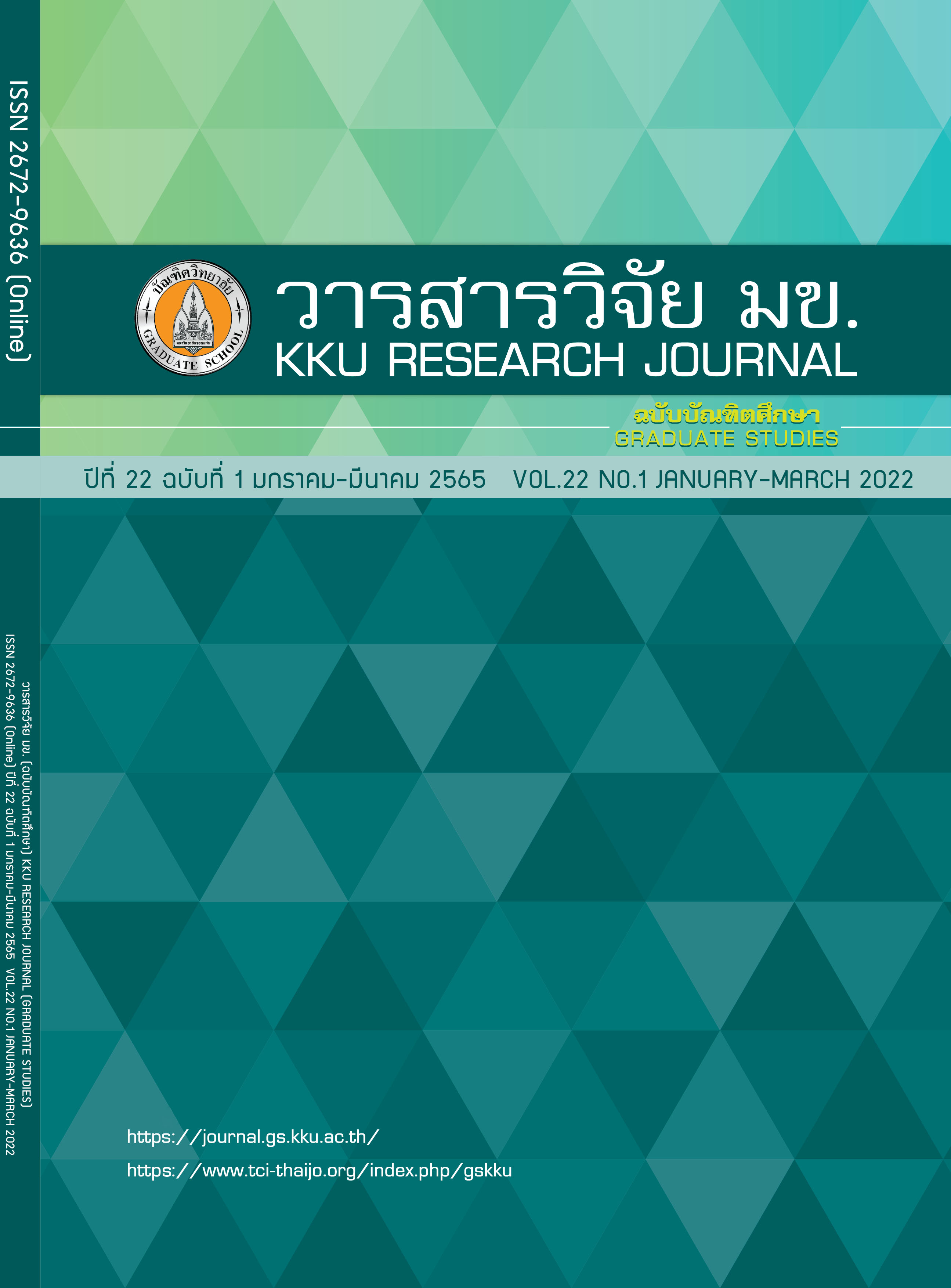Research article Effect of Moisture Content and Grain Position of rice Panicle on the Tensile Force in Separating Processes of Khao Dawk Mali 105 and Phitsanulok-2 Rice Varieties
Keywords:
Panicle of rice, Tensile force, Rice moisture contentAbstract
The objective of this project was to study the effect of moisture contents and grain positions on the tensile force of rice panicle in separating processes of Khao Dawk Mali 105 and Phitsanulok-2 rice varieties. The moisture contents 6 levels of Khao Dawk Mali 105 were studied; 11.77, 16.38, 23.34, 28.38, 31.76 and 38.36 % w.b. Also, the 5 levels of Phitsanulok-2 were 12.72, 18.57, 26.42, 31.73 and 37.43% w.b. The tensile forces were measured at 3 grain positions of lower, middle and upper of rice panicle. The results showed that the moisture contents and grain positions had statistically significant on the tensile force, but there was no interaction between the moisture contents and positions of rice panicle. The average tensile forces of Khao Dawk Mali 105 and Phitsanulok- 2 were the range of 0.945-1.467 and 1.067-1.641 N, respectively. Moreover, the highest and lowest tensile force was found at the lower and upper, respectively.
References
Chinsuwan W, Choun-udom S, Phayom W. Rice Harvest Losses Assessment, Agricultural Sci. J. 33 : 6 (Suppl.) : 242-247. 2002. Thai.
Thai Rice Exporters Association. Thai rice export statistics [Internet] 2560. [Cited 2019 Feb 9]. From : http://www.thairiceexporters.or.th/.pdf
Chinsuwan W. A Study on assessment of performance of rice combine harvesters for reducing harvest losses and increasing potentiality in export. Final report, National Science and Technology Development Agency (NSTDA). 2010. Thai.
Chinsuwan W, Choun-udom S, Udompettaikul V, Phayom W, Panya N. Harvest losses of hommail rice due to manual harvesting and the use of combine harvester. KKU Research J 4(2): JULY-DEC 99 Thai.
Ichikawa T, Sujiyama T. Development of a new combine equipped with screw type threshing and separating mechanism. JARQ-Japan Agricultural Research Quarterly, 20: 31–37. 1986.
Kadangna P, Suwatkrul N, Sukjarean A. Study of the roughness of rice ears. National Agricultural Machinery Center Kasetsart University Research and Development Institute. KU Research 5(14) (August-November 1991) 25-31. Thai.
Lee S, Huh W, YK. Threshing and cutting forces for Korean rice. Transactions of the ASAE, 27: 1954–1957.
Szot B, Ferrero A, Molenda M. Binding force and mechanical strength of rice grain. International Agrophysics, 12: 227–230 1998.
Oduori MF, Mbuya OT, Sakai J, Inoue E. Shattered rice grain loss attributable to the combine harvester reel: Model formulation and fitting to field data. Agricultural Engineering International: the CIGR Ejournal. Available at: http://www.cigrjournal.org/index.php/Ejounral/article/ view/1023/1016 (accessed March 2, 2011)
Fangping X, Xiwen L, Chuzhon T. Rice grain separation force of ear. Study on grain and spikelet’s detaching force of paddy rice. Journal of Hunan Agricultural University (Natural Science), 30: 469–471 2004.
ASAE Standards. Standards engineering practices data. 4th ed. MI: American Society of Agricultural Engineering. 1993.
Alizadeh, Allayed. Threshing force of paddy as affected by loading manner and grain position on the panicle. Research in Agricultural Engineering, 57(1), 8–12. https://doi.org/10.17221/13/2010-rae. 2011.
IBM Crop. Released. IBM SPSS Statistics for Windows, Version 26.0. Armonk. Armonk, NY: IBM Corp. 2019.
Zhang L, Yang Z, Zhang Q, Guo H. Tensile properties of maize stalk rind. BioResources, 11(3), 6151–6161. https://doi.org/10.15376/biores.11.3.6151-6161. 2016.
O'Dogherty MJ, Huber JA, Dyson J, Marshall CJ. "A study of the physical and mechanical properties of wheat straw," J. Agricultural Engineering Research 62(2), 133-142. DOI:10.1006/jaer.1995.1072. 1995.
Downloads
Published
Issue
Section
License
Copyright (c) 2022 KKU Research Journal (Graduate Studies)

This work is licensed under a Creative Commons Attribution-NonCommercial-NoDerivatives 4.0 International License.



